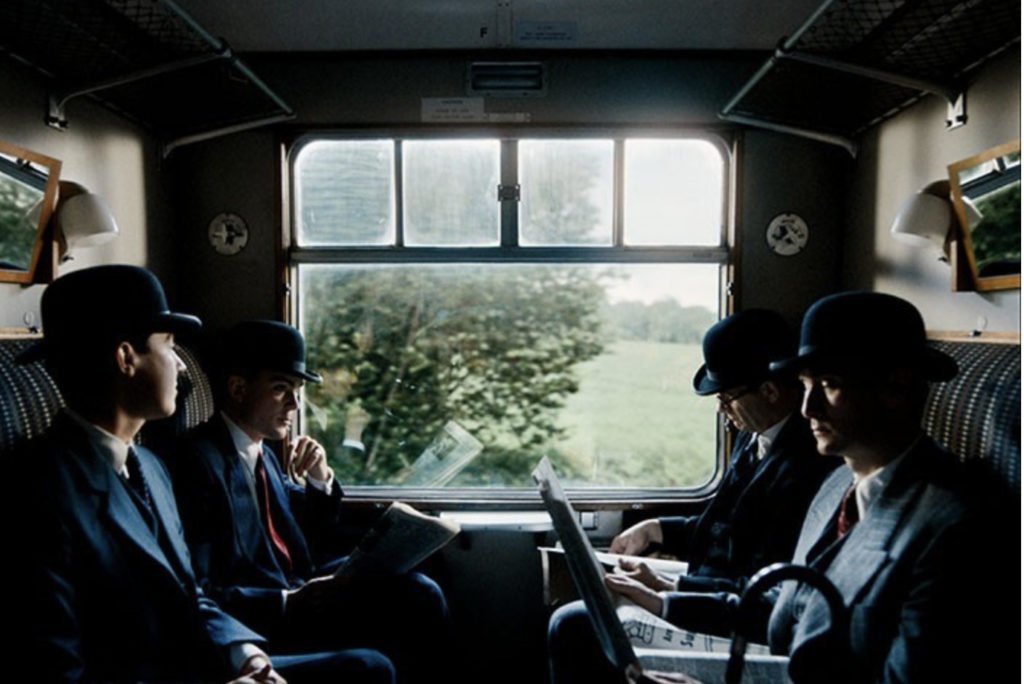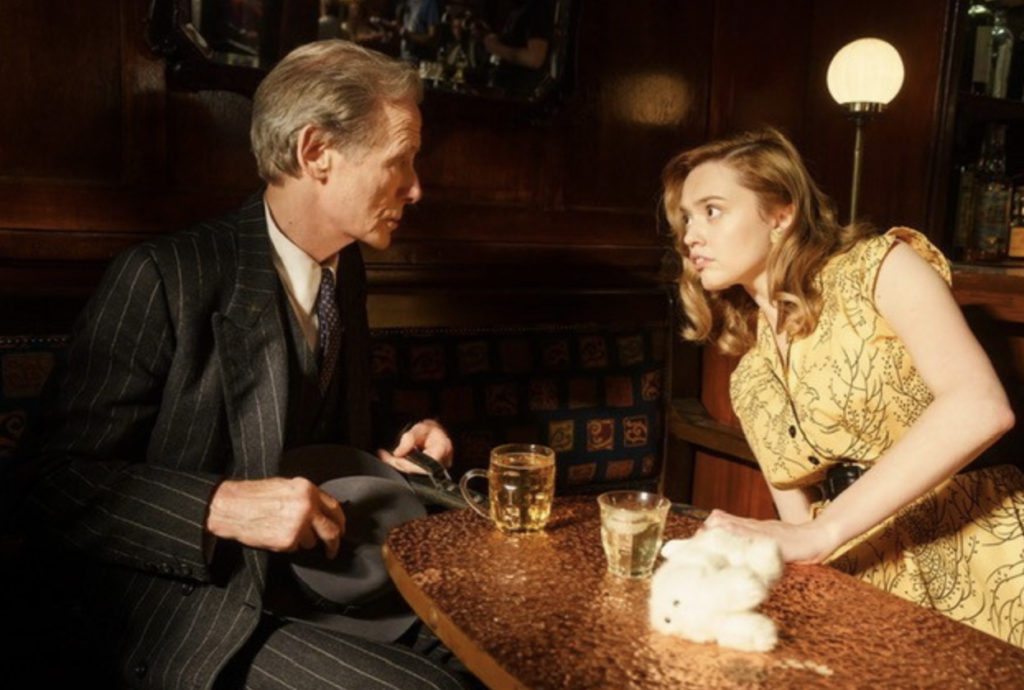

Q: Even though this film takes place in a totally different setting from”Ikiru,” the original film, it’s a daunting task to reimagine the original. At what point did you have the confidence to say, “I can tackle this”? How did producer Steve Woolley approach you for this project — Is it right after you received the script?
OH: When I was first approached, it seemed like, maybe not a good idea, because it was based on this big movie by the famous [Akira] Kurosawa as the background. I had to really think about it. I met with the team producer Steve [Wooley] and writer Kazuo Ishiguro, and essentially it then got to the point where all the reasons not to do this were reasons to do it. I just decided to do it and started working with them. Once we began, we actually were able to make our own film. We didn’t really feel in any way like we were focused on Kurosawa’s. We just did what we wanted to do with the movie.
Q: Right from the beginning, there’s a technicolor-looking image of 1950s people walking down the street, and a key character, Peter Wakeling [Alex Sharp], is waiting in the train station. It really sets the mood for this scene of manners on the train in the 1950s. You are originally from Cape Town, South Africa, and you made a transition yourself to a very different setting. How was so it carefully crafted?
OH: I was looking at references to old imagery and was watching a lot of films [from that era]. I wanted London to be quite cinematic, so that meant that I was playing a lot with tropes that I’d seen in old movies that I really liked, and had developed ideas that I had from photography — approaching England really as an outsider and really wanting to make it my own. The reason why the producers also wanted me to do this film was because I wasn’t from the UK and that I would, somehow, bring a different eye to it. There was the invitation to do that, so I was very willing to pick and choose how I wanted to frame England.
Q: Initially, a US production of “Ikiru” was announced with Tom Hanks attached to it, but it didn’t happen. When the English production tackled the reimagining of it, some of the bureaucratic elements and politeness could transition to the English setting. How much were you conscious of preserving those elements from the original and adapting them into this film?
OH: We were very conscious. The amazing, interesting fact of “Living” is that it’s about a man in England in the ’50s and the original is about a man in Tokyo in the ’50s as well so they’re comparable. It’s something shared between them in terms of life experience. It makes you realize that by retelling the story in the right context in the right period in the UK, it made it a valid thing to do because it’s seemingly appropriate as a story in both societies.

Q: What went into the process of having Bill Nighy sing a traditional Scottish song called “The Rowan Tree”?
OH: The song was in the script, and I started looking for a reference to it, like recordings of the song. It was very hard to find, actually. The ones we found I never liked. In fact, at the point where I asked the screenwriter [Ishiguro] to change the song, I was suggesting other songs to him because I didn’t think that “The Rowan Tree” was cinematic at all. He then explained that it was actually one of his wife’s favorite songs and she would often sing it around their house. What I then did is, I found a song that rhythmically I liked, and asked our music supervisor [Emilie Levienaise-Farrouch] to reconstruct “The Rowan Tree” in a different key, tempo, and completely different rhythm. That felt more cinematic to me, and once I’d done that, I sent it to Bill, told him to learn it and he did that version. It allowed it to be more emotional because the song was a bit more melodic in the way that we did it. It allowed him to have a piano accompaniment. In fact, the woman who was the inspiration for our [songs], Lisa Knapp… We found a song of hers that we really liked and she was a total inspiration how we adapted it. We actually brought her in, and she was so in love with our version that she was prepared to record it so we had her version of the song.
Q: The workers in the office have stacks of files they called the “Skyscrapers” in a confined, bureaucratic work space. Also, you have a black wall. Can you talk about working with the production designer Helen Scott?
OH: The job was exaggerated as a space. We had to make it look plausible knowing that it was slightly implausible. I’m very focused on color, because my background is in photography. So the biggest stretch for me with the office was that I wanted to have black walls but knew that the furniture couldn’t be black. The furniture would have to have wood tones and we’d have to make all those piles up. One of the simplest things we did when we tested out the piles was to make sure that there were gaps between them so we could look through them with the camera and shoot these extraordinary stacking systems that made them tall but didn’t make them dense. When you photograph the table in a wide shot, you sense the stacks but you can still see the characters through them. That was one of the many different ingenious things that Helen discovered and did.
Q: Aimee Lou Wood’s character, Margaret, is such a cheerful and bright person, quite the opposite from Mr Williams, a very important contrast.
What was the process in casting her?
OH: When we did the casting, we got loads of tapes and I watched them. I was in Cape Town, South Africa. I took one look at Aimee Lou Wood’s tape and just knew that she was the one. She had the right humor, warmth, approachability and talent. The dialogue in this film is very cumbersome so we noticed it a lot when we cast — everybody struggled with the dialogue because it’s quite dense. When an actor just surfs it without any restraint, it’s always a great sign of a really, really talented actor.

Q: What does it mean to you that this film was shown on the closing night of the Tokyo Film Festival, and was also released at Toho, where the original Kurosawa film was released?
OH: It’s been amazing to think about that.
When I found out that it was the [home of] his work, and that it was the 70th anniversary of the original film — which Toho was going to be a part of — it made me feel very special. To Steve, it was incredibly special that we got to close the Tokyo Film Festival because it makes it feel that a union between the two films is there, and is complete. From what I’ve been told, the reception was very warm, which felt very reassuring.
Q: Did you recreate that playground?
OH: We built that playground in three different ways. There was a version full of water, the construction version, and a finished version. Then there’s a fourth version which was the one with snow. Another perfect example of Helen’s wonderful work in seeing the potential of a big empty lot. We finished the playground with the effects. We obviously added the effects at both ends so there was digital interlacing at the end of each side of it. It came together really well.
Q: What do you want the audiences to take away from this wonderful film, which also has a certain resonance from the original classic film?
OH: The hope is that the focus and echo of the original is the same message, which is, to be present in your life and find a center that allows you to operate and be part of the world in a fulfilling way — not so much in the sense of grandeur and as a monument to oneself, but in the sense of knowing that on any given day the life that you live, the time you spend, is coming from a place inside of you that’s truthful, connected and self-aware. This movie has a small message but an important one.
Check out more of Nobuhiro’s articles.
Here’s the trailer of the film.

